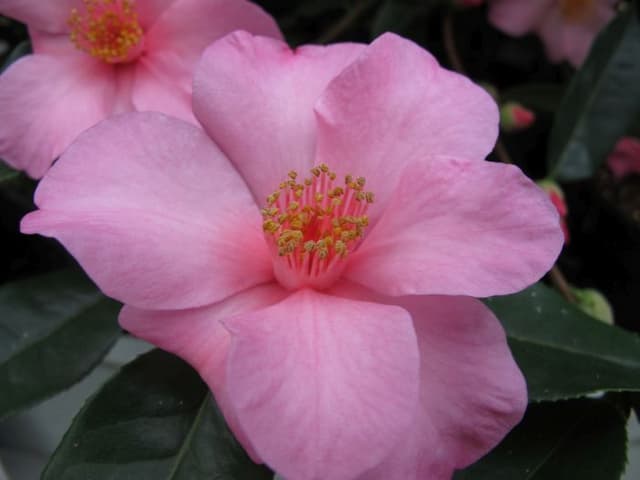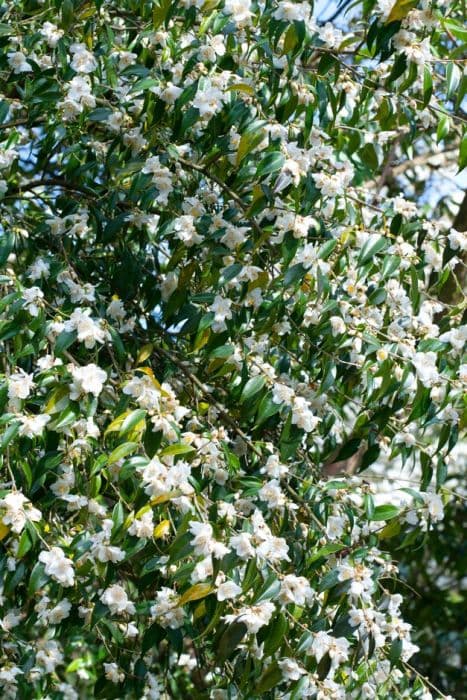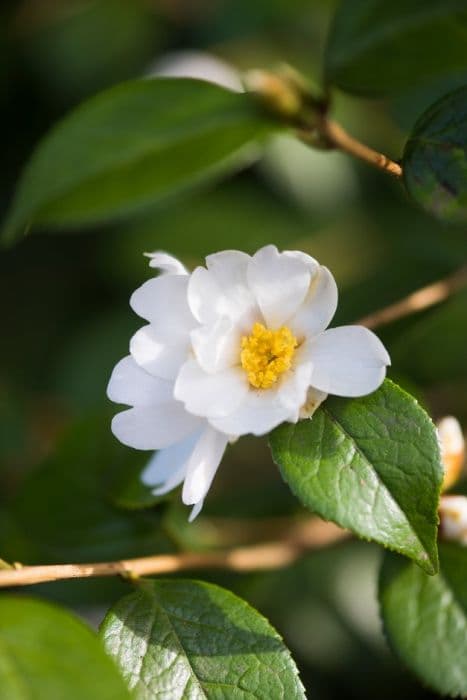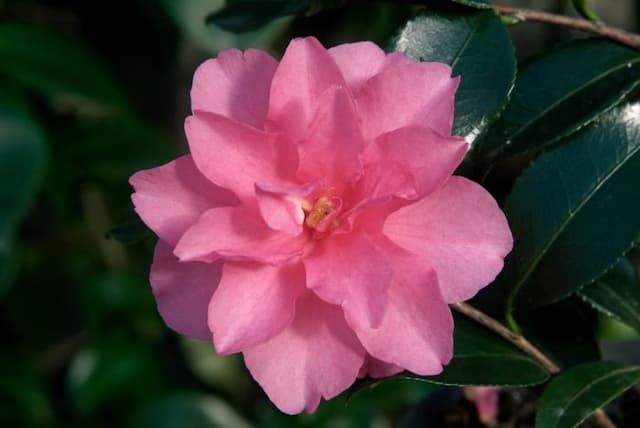Camellia × williamsii 'Julia Hamiter'

ABOUT
Camellia × williamsii 'Julia Hamiter' is best known for its captivating flowers and glossy, evergreen foliage. The blooms on this variety are particularly striking, with a color palette that typically includes shades of soft pink, often adorned with deeper pink streaks or flushes, creating a delightful visual contrast. The petals are usually arranged in a formal double pattern, giving the flower a full and rounded appearance with numerous layers that add depth and complexity to the blossom's structure. At the center of each flower, a cluster of golden-yellow stamens may be visible, offering a warm and inviting focal point. The foliage of 'Julia Hamiter' is no less attractive with leathery, dark green leaves that have a shiny surface. The leaves often have a slightly serrated edge, which adds texture to the overall look of the plant. These leaves create a lush backdrop for the flowers, and they last throughout the year, providing consistent greenery in the garden. Overall, the presentation of Camellia × williamsii 'Julia Hamiter' is one of elegance and beauty, with its showy flowers standing out against the rich, verdant foliage.
About this plant
 Names
NamesFamily
Theaceae.
Synonyms
Williamsii Camellia, Hybrid Camellia.
Common names
Camellia × williamsii 'Julia Hamiter'.
 Toxicity
ToxicityTo humans
Camellia × williamsii 'Julia Hamiter', commonly known as camellia, is not considered toxic to humans. Typically, ingestion of camellia plants does not cause poisoning or adverse health effects in humans. Therefore, there are no specific symptoms associated with the poisoning from this plant, as it is generally regarded as non-toxic.
To pets
Camellia × williamsii 'Julia Hamiter', commonly known as camellia, is generally not considered toxic to pets. It is not known to cause serious illness or poisoning if pets ingest parts of the plant. Consequently, typical symptoms of plant poisoning are not expected if a pet consumes parts of a camellia plant. However, individual animals might have different sensitivities, and ingesting plant material can sometimes cause mild gastrointestinal upset irrespective of toxicity.
 Characteristics
CharacteristicsLife cycle
Perennials
Foliage type
Evergreen
Color of leaves
Dark green
Flower color
Pink
Height
6-10 feet (1.8-3 meters)
Spread
6-10 feet (1.8-3 meters)
Plant type
Shrub
Hardiness zones
7-9
Native area
East Asia
Benefits
 General Benefits
General Benefits- Ornamental Appeal: The Camellia × williamsii 'Julia Hamiter' is highly valued for its aesthetic beauty, having large, colorful blooms that enhance the visual appeal of gardens and landscapes.
- Long Blooming Season: This variety is known for its extended blooming period, which can last from winter through to spring, providing color when few other plants are in flower.
- Drought Tolerance: Once established, this plant has a good level of drought resistance, making it suitable for gardens in areas with variable rainfall.
- Shade Tolerance: It can grow well in partial shade, offering flexibility in garden design and plant placement, especially in shaded or woodland garden settings.
- Low Maintenance: It typically requires minimal pruning and can be cared for with basic gardening practices, appealing to gardeners looking for plants that do not require a lot of upkeep.
- Versatility: This camellia can be used in various ways in the landscape, including as a specimen plant, in mass plantings, or as part of a mixed shrub border.
- Attracts Pollinators: The flowers can attract pollinating insects, which are beneficial for the garden's ecosystem and the pollination of other plants.
- Evergreen Foliage: The plant retains its leaves year-round, providing continuous greenery and structure in the garden even when not in bloom.
- Privacy and Screening: Due to its dense growth habit, it can be used as a privacy hedge or screen, shielding unsightly views and creating secluded areas in the garden.
 Medical Properties
Medical PropertiesThis plant is not used for medical purposes.
 Air-purifying Qualities
Air-purifying QualitiesThis plant is not specifically known for air purifying qualities.
 Other Uses
Other Uses- Floral Arrangements: The Camellia x williamsii 'Julia Hamiter' can be used in cut flower arrangements due to its attractive blooms that add elegance and color to bouquets.
- Hair Decoration: The vibrant flowers can also be utilized as hair decorations for special occasions like weddings or cultural events.
- Photography Prop: The plant's striking flowers may serve as a beautiful prop for nature photography or as a picturesque backdrop for portrait sessions.
- Creative Crafts: Dried Camellia flowers can be used in making bookmarks, greeting cards, or in other craft projects that require decorative floral elements.
- Educational Tool: This plant can be included in botanical studies due to its hybrid nature, helping students learn about crossbreeding and plant genetics.
- Dye Production: The petals of the Camellia can sometimes be used to produce natural dyes for fabrics or art projects.
- Culinary Garnishes: Although not commonly consumed, the flowers can occasionally be used as non-toxic garnishes for plating and food presentation, provided they are free from pesticides.
- Bonsai: Camellia x williamsii 'Julia Hamiter' can be grown as bonsai, providing garden enthusiasts with a challenging yet rewarding miniature tree specimen.
- Specialty Composts: Fallen Camellia leaves can be composted to create an acidic mulch, ideal for fertilizing other acid-loving plants in the garden.
- Artistic Inspiration: The blooms of the Camellia often serve as an inspiration for artists and designers, influencing patterns and motifs in various forms of art.
Interesting Facts
 Feng Shui
Feng ShuiThe Camellia is not used in Feng Shui practice.
 Zodiac Sign Compitability
Zodiac Sign CompitabilityThe Camellia is not used in astrology practice.
 Plant Symbolism
Plant Symbolism- Admiration: The camellia flower is often associated with deep admiration for someone's qualities and beauty.
- Perfection: The flawless form of the camellia bloom is symbolic of the ideal or perfect beauty.
- Longevity and Faithfulness: As an evergreen with a long blooming season, camellias represent the enduring aspect of love, implying lasting devotion and constancy.
- Love: The camellia flower in general is tied to expressions of romantic and platonic love, depending on the color.
- Refinement: The elegance of camellias suggests the refined beauty and sophistication of the recipient.
 Water
WaterThe Williamsii Camellia 'Julia Hamiter' should be watered deeply to ensure moisture reaches the roots, approximately once a week, but this may vary depending on climate conditions and soil types. During dry spells or in hotter seasons, you may need to water more frequently, perhaps every 4-5 days, to maintain consistent moisture. The goal is to keep the soil moist but not waterlogged. In general, you should aim to provide the camellia with about 1 to 1.5 gallons of water at each watering session, slowly poured around the base of the plant to avoid wetting the foliage, which can lead to fungal diseases. Always check the top few inches of soil for dryness before watering to avoid overwatering.
 Light
LightThe Williamsii Camellia 'Julia Hamiter' thrives in partial shade to dappled sunlight. It prefers bright, indirect light, avoiding the intense midday sun which can scorch its leaves. A location that receives morning light and afternoon shade, or filtered light through a canopy of taller trees, is ideal. Direct sunlight, particularly in the summer months, should be avoided to protect the plant's delicate flowers and foliage.
 Temperature
TemperatureThe Williamsii Camellia 'Julia Hamiter' prefers a temperate range with ideal temperatures between 60°F and 80°F. It can tolerate minimum temperatures down to about 20°F, but frost can damage the flowers and buds. Protect the camellia from harsh winter winds, which can desiccate and damage the foliage. During the summer months, ensure the camellia has some protection from heat above 90°F, as excessive heat may stress the plant and cause bud drop.
 Pruning
PruningThe Williamsii Camellia 'Julia Hamiter' should be pruned for shaping, size control, and to remove dead or diseased wood. The best time to prune is immediately after flowering ends in spring, as pruning too late can remove next season's flower buds. Thin out dense growth to increase air circulation and make light pruning cuts to maintain the desired shape. Pruning should be carried out sparingly, as camellias do not need heavy pruning.
 Cleaning
CleaningAs needed
 Soil
SoilWilliamsii Camellia thrives in acidic soil with pH 5.5-6.5. A well-draining mix with organic matter like peat moss and perlite is ideal. Regularly amend the soil to maintain acidity and drainage for optimal growth.
 Repotting
RepottingWilliamsii Camellias should be repotted every 2-3 years. It's best done in spring, before the new growth starts. Choose a pot that's slightly larger than the current one to allow for growth.
 Humidity & Misting
Humidity & MistingWilliamsii Camellia prefers high humidity levels, around 50-60%. It benefits from regular misting or a nearby humidifier, especially during drier months.
 Suitable locations
Suitable locationsIndoor
Bright, indirect light, and consistent temps for Williamsii Camellia.
Outdoor
Plant in partial shade, protect from strong winds for Williamsii Camellia.
Hardiness zone
7-10 USDA
 Life cycle
Life cycleThe life of the Camellia × williamsii 'Julia Hamiter', commonly known as Williamsii camellia, begins with seed germination, which is generally slow and can take several months. Once the seedlings emerge and establish, they enter a vegetative growth phase, producing glossy, evergreen leaves and a bushy structure. After a few years, when the plants are mature enough, they begin the reproductive phase, flowering typically in late winter to early spring with large, showy blooms ranging from white to pink and red. Post-pollination, if successful, will lead to the formation of seed pods that, after maturing, will release seeds to restart the life cycle. During its lifetime, the plant may also propagate asexually through cuttings, which is a common method used by gardeners to clone and preserve desired varieties. With proper care and favorable conditions, Williamsii camellia can live for several decades, continuing its cycle of growth and reproduction.
 Propogation
PropogationPropogation time
Spring-Early Summer
The Camellia × williamsii 'Julia Hamiter', commonly known as Japonica or Williamsii Camellia, is most effectively propagated using semi-hardwood cuttings, although they can also be grown from seed or by air layering. For semi-hardwood cuttings, the ideal time is late summer after the new growth has begun to mature. One popular method involves taking a cutting that is about 4-6 inches long, with several sets of leaves, and stripping the bottom half of the foliage. The cut end is then dipped in rooting hormone powder to encourage root growth. The prepared cutting should be inserted into a mix of peat and perlite or a similar well-draining, sterile medium and kept at a consistent humidity and temperature, usually using some form of misting system or plastic covering to maintain a favorable environment. Roots generally begin to form within 1 to 3 months, after which it can be transplanted.









